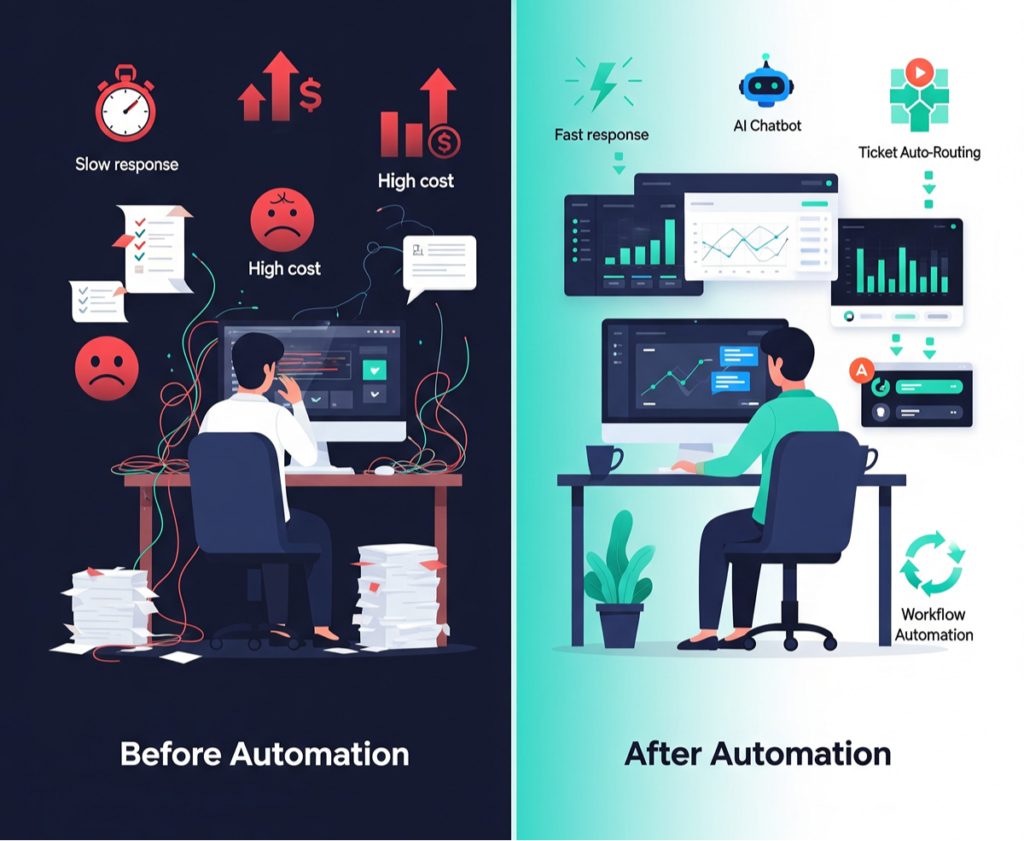It goes without saying that your employee productivity and user satisfaction are directly proportional to the performance of your IT Service Desk.
If your IT Service Management (ITSM) framework isn’t delivering fast, cost-effective, and user-centric support, you’re likely losing time, money, and trust.

The three most common productivity gaps or ITSM failures are:
1. High Mean Time to Resolve (MTTR) Signals Operational Inefficiency
2. Escalating Cost per Ticket Points to Inefficient Resource Utilisation
3. Declining User Satisfaction Indicates a Broken User Experience
1. High Mean Time to Resolve (MTTR) Signals Operational Inefficiency
MTTR, or Mean Time to Resolve, is a critical metric in ITSM that reflects how quickly your team addresses and resolves incidents. A consistently high MTTR is a major red flag; it means your service desk is struggling to deliver timely support.
Common Causes of Long Resolution Times
- Manual Ticket Assignment: Without an auto-assignment engine, tickets often sit idle waiting for someone to pick them up. Implementing AI-powered routing algorithms ensures faster triage and response.
- Fragmented Data Access: If your IT agents have to hunt through siloed systems for relevant information, valuable time is lost. Centralised data repositories improve visibility and speed up resolution.
- Lack of Team Collaboration: Poor internal coordination leads to miscommunication, redundant work, and delays. Automating cross-team workflows and enabling real-time collaboration tools can dramatically improve resolution speeds.
Automation reduces MTTR by streamlining workflows, centralizing knowledge, and enabling intelligent ticket routing, all essential to faster service delivery.
2. Escalating Cost per Ticket Points to Inefficient Resource Utilisation
Another sign of an ITSM failure is the rising cost per ticket, which represents the expense incurred for resolving each service request. A bloated ticket cost is often tied to inefficient practices and underutilised resources.
Key Drivers of High Ticket Costs
- Inefficient Use of IT Agents: Overloaded or misaligned support teams result in wasted manpower. With the help of automation, you can balance workloads and optimise agent performance.
- Extended Handling Time: Manual processes prolong the lifecycle of each ticket. Automating repetitive tasks reduces handle time, lowers costs, and frees up staff for high-value work.
- Absence of Self-Service Options: Without a knowledge base or AI-driven chatbots, your service desk becomes the first line of defence for every minor issue. Empowering users with self-help tools significantly decreases ticket volume and associated costs.
An automated, self-service-first ITSM approach can slash support costs, improve resolution time, and boost agent efficiency
3. Declining User Satisfaction Indicates a Broken User Experience
User satisfaction is the heartbeat of your service desk and when it drops, the entire ITSM strategy suffers. Negative feedback on surveys or rising complaint volumes are clear indicators that your support system isn’t meeting expectations.
Factors Contributing to Poor User Experience
- Manual and Sluggish Processes: Repetitive, time-consuming steps frustrate users and erode trust in IT.
- Lack of Transparent Communication: Users want visibility into their ticket status. When updates are inconsistent or non-existent, satisfaction plummets.
- No Self-Help or AI Assistance: Today’s users expect self-service portals, FAQs, and AI chatbots that provide instant answers. Without them, dependency on agents increases and satisfaction declines.
- Unstructured Feedback Handling: Collecting user feedback isn’t enough—you must analyse it systematically and implement meaningful improvements based on it.
Automated ITSM tools provide proactive communication, real-time updates, and intelligent self-service options that enhance the overall user experience.
Root Cause of ITSM Failure: Disconnected Tools and Manual Workflows
The primary issue behind these productivity gaps? A lack of an integrated and automated ITSM ecosystem. Most underperforming service desks rely on disconnected tools and manual processes, which lead to human error, increased costs, and poor visibility.
The Automation Advantage
By introducing automation into your ITSM framework, you can:
- Route tickets automatically based on priority and category
- Automate approvals and escalations
- Provide AI-based resolutions via chatbots
- Track and optimise performance with real-time analytics
- Offer a 24/7 self-service portal to deflect basic queries
Implementing a Scalable ITSM Automation Strategy
Transitioning to ITSM automation doesn’t have to be complex. The key is choosing a solution that aligns with your organization’s goals and existing workflows.
At Input Zero Technologies, we bring over a decade of expertise in transforming IT service delivery through intelligent automation. As certified elite partners of ServiceNow, we help enterprises:
- Deploy smart ticketing systems
- Streamline change management
- Automate incident, problem, and request handling
- Enhance end-user engagement through AI and analytics
If your IT service desk is bogged down by inefficiency, rising costs, and user dissatisfaction, now is the time to embrace automation. Don’t let outdated processes hold your business back.
Want to talk to us more about this? Click here



